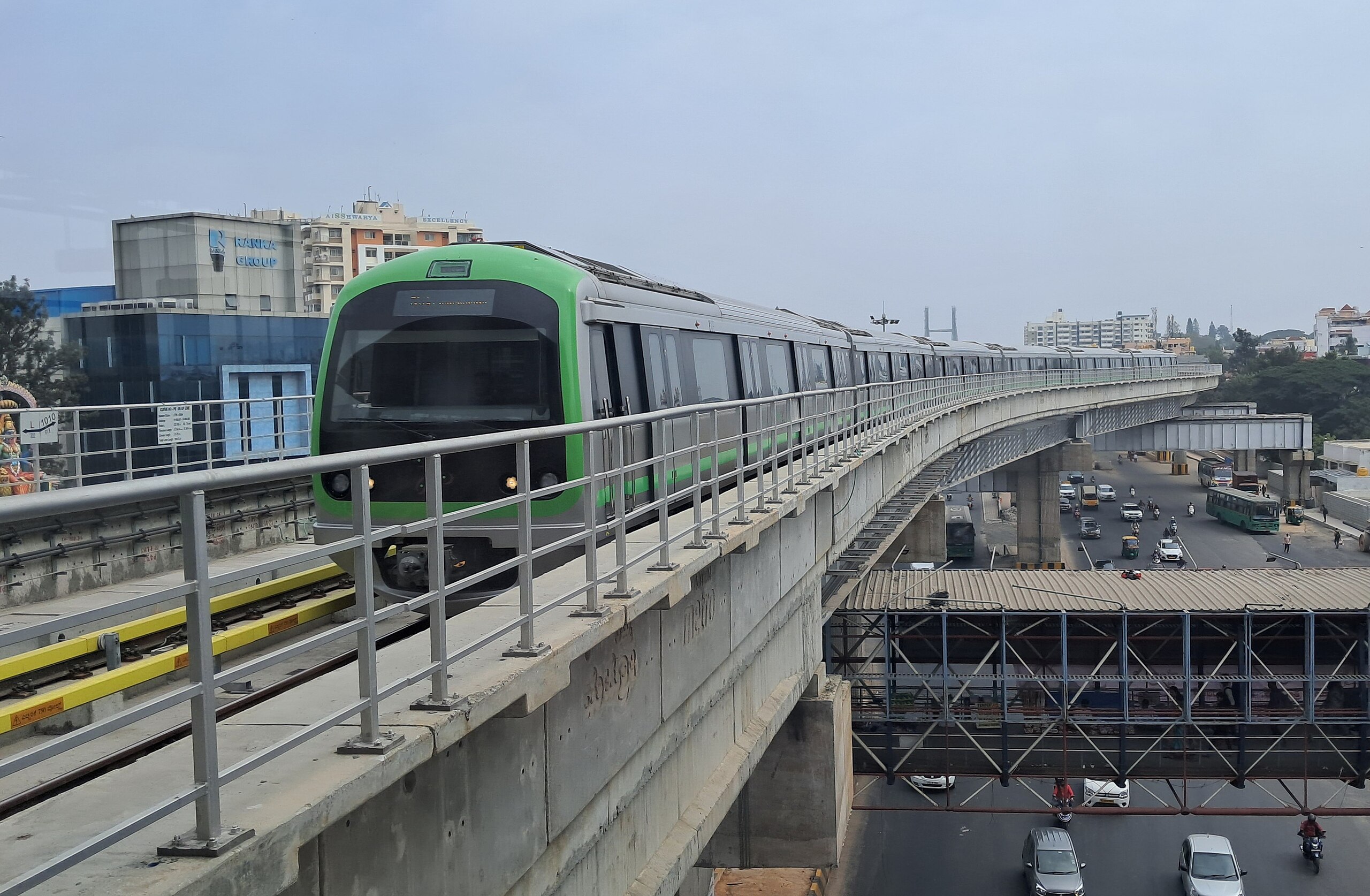Metro Line: Green line
The Namma Metro Green Line in Bengaluru, Karnataka, India, was developed concurrently with the Purple Line during the first phase of the metro rail system’s construction. Covering a distance of 30.5 kilometers (19.0 miles), this crucial transit route connects Nagasandra in the northwest to Silk Institute in the south, serving as a vital transportation link for Bengaluru residents.
Line: Green line All Metro Stations
Loading
Line: Green line Quick Info
- Status: Opperational
- Operational Stations: 29
- Under Construction Stations: 3
- Line Length: 30.69 km (19.07 mi)
- Tracks Number: 2
- Operating Speed: 40 km/h (25 mph)
- Daily Riderships:62.3 million as per 2019
Gren Line Terminals
Namma Metro Green Line Overview
The Namma Metro Green Line in Bengaluru, Karnataka, India, was developed concurrently with the Purple Line during the first phase of the metro rail system’s construction. Covering a distance of 30.5 kilometers (19.0 miles), this crucial transit route connects Nagasandra in the northwest to Silk Institute in the south, serving as a vital transportation link for Bengaluru residents.Route and Connectivity
The Green Line establishes essential connections, linking industrial centers such as Peenya and Yeshwanthpur in the north with the central hub of Majestic and the southern residential areas of Bangalore, including Basavanagudi, Jayanagar, Banshankari, and Kanakapura Road. Notably, the Majestic station serves as a pivotal interchange point between the Green and Purple Lines, enhancing overall metro network connectivity.Construction Phases
Phase I
The construction of Reach 3 and 3A of Phase I commenced in 2009–10, with a project cost of ₹2,100 crore. Utilizing Tunnel Boring Machines (TBMs) named Kaveri, Krishna, and Godavari, the Green Line’s underground section faced challenges but achieved its first trial run on 8 August 2013. The initial section became operational on 1 March 2014, experiencing significant ridership in its inaugural month.Phase II
Phase II introduced extensions, including Reach 4B from Yelachenahalli to Silk Institute and Reach 3C from Nagasandra to Madavara. The extension to Silk Institute began commercial operations on 14 January 2021, marking a milestone in Phase II. Reach 3C’s construction is expected to conclude by June–August 2022.Technical Details
The Green Line predominantly consists of elevated sections, featuring 26 elevated stations and 3 underground stations. With Majestic station serving as a key interchange, the Green Line is a crucial component of Bengaluru’s evolving metro infrastructure.Frequency and Capacity
Initially operating from 6 am to 11 pm, the Green Line extended its operational hours from 5 am to 11 pm on 1 December 2015. The frequency along the line varies between peak and non-peak hours, with a 15-minute interval during specific periods. The journey time for the 24.2 km route is approximately 42 minutes, and each six-coach train boasts a capacity of 2,004 passengers. In summary, the Namma Metro Green Line stands as a fundamental element of Bengaluru’s public transportation network, facilitating seamless connectivity and enhancing the city’s overall mobility infrastructure.FAQ's
What are the key areas connected by Bengaluru's Metro Green Line?
Bengaluru's Metro Green Line serves as a vital link connecting Nagasandra in the northwest to Silk Institute in the south. It facilitates seamless connectivity between industrial centers like Peenya and Yeshwanthpur in the north, the central hub of Majestic, and southern residential areas including Basavanagudi, Jayanagar, Banshankari, and Kanakapura Road. The Majestic station acts as a crucial interchange point between the Green and Purple Lines, enhancing overall metro network connectivity.
How was the construction of Bengaluru's Metro Green Line executed during Phase I?
Phase I construction involved the commencement of Reach 3 and 3A in 2009–10, with a project cost of ₹2,100 crore. Notable elements include the deployment of Tunnel Boring Machines (TBMs) named Kaveri, Krishna, and Godavari for the underground section. The first trial run occurred on 8 August 2013, marking a significant milestone. Despite challenges, the inaugural section of the Green Line became operational on 1 March 2014.
What extensions are introduced in Phase II of Bengaluru's Metro Green Line?
Phase II introduces two significant extensions: Reach 4B from Yelachenahalli to Silk Institute and Reach 3C from Nagasandra to Madavara. Reach 4B was inaugurated on 14 January 2021, marking the first operational section of Phase II. Reach 3C's construction, awarded to Simplex Infrastructure Limited, is anticipated to be completed by June–August 2022, contributing to the continued expansion of the Green Line.
How long is Bengaluru's Metro Green Line?
Bengaluru's Metro Green Line spans a distance of 30.5 kilometers, linking Nagasandra in the northwest to Silk Institute in the south. With 26 elevated stations and 3 underground stations, it forms a crucial transportation artery in the city.
When did the first section of Bengaluru's Metro Green Line become operational?
The first section of Bengaluru's Metro Green Line became operational on 1 March 2014. BMRCL Managing Director Pradeep Singh Kharola noted that about 25,000 passengers traveled on the line on the opening day, marking a successful initiation of service.


